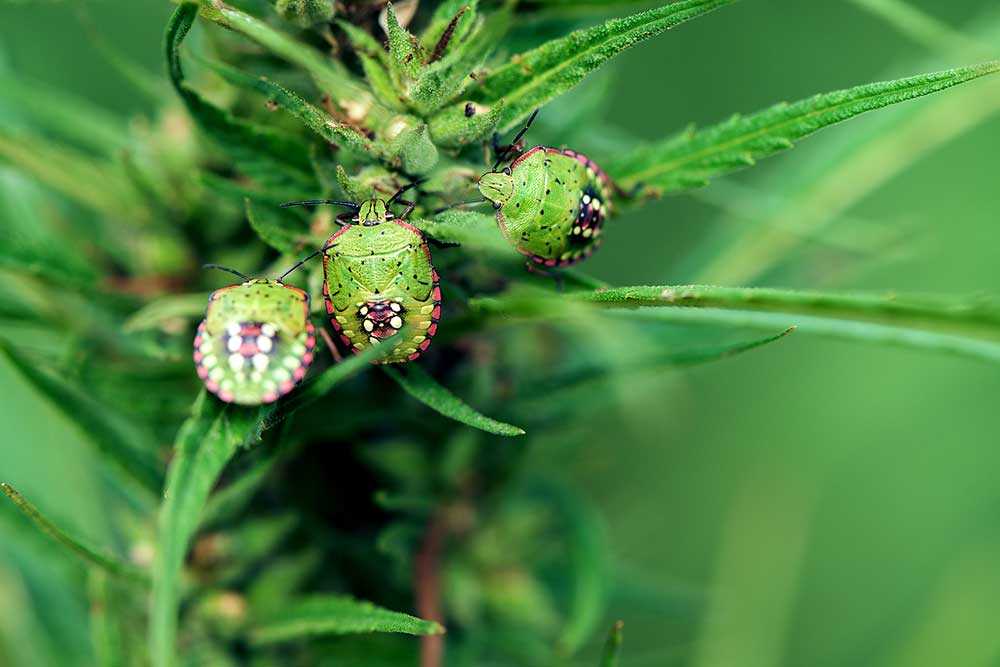Are You 21 Or Over?
YesOr
No By clicking yes, you certify that you are over 21 years old. By using this website, you agree to our legal disclaimer.Table of Contents

Just like any other plant, growing cannabis has its distinct problems. Pests, bugs, and viruses can attack your crops. If left untreated, these annoyances can kill your plants. A grower should always make an informed decision to apply the best method in dealing with these nuisances.
The good news is that many of the same pest species are also the bane of many flowers and plants. You might think, “How is that good news?” Hence, the solutions to getting rid of these sources of displeasure are readily available on the market.
There are two main categories of insect pests that attack plants: (1) chewing insects with mouthparts that eat sections or entire leaves and (2) sucking insects that pull the nutrients out of a plant. Let’s first look at the common sucking pests that cannabis growers need to check in their crops.
Spider mites aren’t real insects as they’re classified as arachnids. Using traditional insecticides won’t work on these pests as their biology is different than insects. These bothersome critters feed on the chlorophyll of leaves. Growers will find evidence of the existence of spider mites in their plants if you see a mottled or speckled appearance on leaves.
The mites are difficult to see without an item used for magnification. Still, spider mites are just like ordinary spiders. You’ll find webs and other similar damage to the leaves.
Whiteflies will quickly make their presence known once you start planting your cannabis plants. Marijuana growers who brush against their plants should see a cluster of these pests flying about. These insects look like a puff of smoke. Despite their diminutive looks, whiteflies will feed off of the nutrients of your plants.
Like spider mites, whiteflies will leave mottled spots on leaves. The difference with the appearances of their damages is that the harms are more visible when done by whiteflies.
There are some pests that are difficult to spot but fungus gnats aren’t in that category. While growers grow cautious (no pun intended) of adult insects, it’s the larvae of fungus gnats that can cause more harm. The adult gnats will spread disease in the grow room. However, these older pests don’t feed on the plants. Instead, the larvae will feed off of the roots of the plants.
To know if you have a fungus gnat problem, the plants may appear to have stunted growth. Even if your cannabis plants will continue to grow, the stress on the plant brought by these pests makes them more susceptible to other illnesses.
Caterpillars turn to beautiful butterflies but before that happens these insects can become pests for plants. The sizes of these crawlers range from almost invisible to several inches in length. Also, they can sometimes blend well with their surroundings making them tough to spot.
Evidence of caterpillar infestation is viewed as holes in leaves. Sometimes leaf margins have chew marks on them evident of caterpillar presence.
A more problematic concern than caterpillars is snails and slugs. These slimy beings can become a real threat to marijuana plants. Aside from leaving a slimy, mucous-like trail, they feed on the leaves like there’s no tomorrow.
Just as their name implies, root maggots feed on your plants’ roots. Just like the larvae of fungus gnats, you’ll see evidence of damage if your crops weaken. Furthermore, there may seem like there’s too much water in your grow area or other nutrient deficiencies are present.
Leaf miners are perhaps the pickiest of pests. It doesn’t attack all strains of marijuana. Instead of directly attacking or chewing on leaves, leaf miners take about two weeks before dealing damage to your plants. It deposits eggs first inside the leaves. Then, the larvae begin to dig tunnels which are easily seen because of the evidence of holes.
Once you see those holes, it’s important to take immediate action. Aside from the holes, you’ll see brown lines found on the leaves of your plants. These are the tunnels which the larvae use to eat your plants in their paths.
One of the real headaches regarding cannabis cultivation is thrips. These pests are tiny insects that move very fast. Growers should immediately take action upon seeing any damage caused by these crawlers. Preventing these insects from eating your crops is possible by spraying either Neem essential oil or potassium soap on your plants. Still, if the damage is already too severe, then you may need to be on your knees to exert effort on healing.
Evidence of thrips infestation is a yellow sticky strip around the crop. This residue is akin to a double-edged sword to the insects as some of the pests can stick to it. You’ll also know if there are thrips in the area if there are silver markings found on the leaves. These silver blotches can come with dots. The dots are excretions which may also come with signs of brittleness on leaves.
Cochineal is a plague to most gardeners. Even if you don’t cultivate cannabis plants, you’ve probably heard of cochineals. These can attack your crops even if they’re indoors. It also acts with stealth, precision, and haste. Also, they’re small in size. These pests are even tinier than many of the small insects that feed on plants. Even worse, cochineals are resistant to insecticides.
Growers can recognize cochineals by their white or brown color. These insects have a white fluffy texture on their tiny bodies. They start to appear on the stems of your crops before spreading across other areas. Ants are also an indication of the presence of cochineals.
The origins of plant viruses remain a mystery. There are, however, three theories explaining their origins: the Cellular origin hypothesis, the Regressive hypothesis, and the Coevolution hypothesis.
The Cellular origin hypothesis explains that viruses came from bits of DNA and RNA found in larger organisms. As for the Regressive hypothesis, viruses were once small cells combined together with a parasite to recover their lost genetic material over time. Last, the Coevolution hypothesis explains that the viruses came from nucleic acid and protein molecules.
Despite different thoughts of their origins, cannabis viruses, or plant viruses in general, are intracellular parasites. These molecular beings cannot replicate without a host.
As its name implies, the Tobacco Mosaic Virus (TMV) mainly infects the tobacco plant. It also contaminates other members of the nine plant families. This disease can also taint cannabis plants.
Growers can see evidence of a TMV infestation or plague when discoloration takes place on the veins of the leaves. This staining shouldn’t be confused with nutrient deficiency. If left untreated, the discoloration proceeds to motting that looks something like a mosaic. There will be a light and dark pattern appearing on the leaves.
Furthermore, a wrinkly texture may develop on the leaves which can lead to it becoming contorted or curved. The lower leaves may also present evidence of mosaic burn, especially if the plants are in hot and dry climate conditions.
Despite looking like a deadly disease, TMV is one of the most stable viruses found among plants. Growers can stabilize the infection by making sure the grow area doesn’t drop below 40 degrees Celsius. Marijuana plants inside greenhouses are at an ideal environment for halting TMV in its tracks before it spreads.
Aside from TMV, there are also other common marijuana viruses that may infect cannabis strains. These include Hemp mosaic virus (HMV), Hemp streak virus (HSV), Tobacco Ringspot virus (TRV), Tobacco streak virus (TSV), Alfalfa mosaic virus (AMV), Arabis mosaic virus (ArMV), Cucumber mosaic virus (CMV), and the Tomato ringspot virus (TomRSV).
Different bugs and pests call for varying solutions to properly deal with them. Growers may choose to go with either synthetic or biological pest control techniques. Synthetic chemicals include pesticides and fungicides. Remember, these chemically-infused solutions may also damage your plants despite their effectiveness in removing common plant pests. If the chemicals are too strong, then these might end up killing your crops.
There are also biological or organic methods that are highly effective in dealing with common cannabis pests. These techniques may help in keeping small bugs and insects at bay. Some of these organic techniques may even contribute to the healthy growth of your plants.
Growers may also apply barriers and repellents to keep pests away from the row area. The walls help in preventing crawling insects from accessing your cannabis plants. You can also opt for simmering cedar twigs in water. This organic solution will help deter corn earworms, cutworms, and other similar pests. Snails and slugs also won’t dare cross areas with water or lime. It’s a similar scenario when deterring ants with the help of iron phosphate or cayenne pepper.
The use of sprays and organic pellets aren’t the only solutions to prevent and eliminate bugs and pests that may otherwise feast on your cannabis plants. There are even some insects that work to eliminate other bugs. These insects are akin to living, breathing pesticides that can even contribute to the overall health of your crops.
One example of beneficial insects is the ladybug. Many ladybug species are easily found in the wild. There are even some specialized stores that sell these helpful critters. Ladybugs will have a strong appetite for eating small caterpillars, mites, and cochineals. Other insects that can satisfy the palate of ladybugs include aphids.
Another insect that can bring advantages to your cannabis plants is the mite. Now, mites are often connected with negative connotations. However, not all mites are seen as detrimental. For example, the Phytoseiulus persimilis is a species of mite with a small size and red color. These insects feed on spider mites. Also, Phytoseiulus persimilis likes to feed on the larvae and eggs of spider mites. If you see evidence of spider mites in your cannabis plants, you may want to seek help from the Phytoseiulus persimilis bug.
Last, but definitely not the least, is the anthocoridae. This beneficial bug also feeds on spider mites much like its Phytoseiulus persimilis cousin. Aside from eating spider mites, it also likes to eat small caterpillars. The way anthocoridae feast on their prey starts by tackling their victims. When casualty begins to weaken, these small insects start to pierce their “food” by using their three-segmented beak. It injects their kill with digestive enzymes afterward.
Growers can also make use of parasitic wasps and spiders. For the former, the parasitic wasp will attack spiders, flies, beetles, and bugs that may deliver harm to your marijuana strains. Spiders, on the other hand, are helpful critters for cannabis gardens. Spinning webs around the different areas of the marijuana plant will trap a broad range of pests. Also, most spiders aren’t picky eaters. Hence, if another insect gets caught in its web, then the spider won’t hesitate to feast on their flesh.
Cannabis virus prevention and treatment have similar practices to averting cannabis plant pests and diseases. Removal of dead plant material, proper maintenance, and the cleanliness of grow areas still play vital roles in the overall health of your plants. Also, remember that some strains are more resistant to viruses than other cannabis plants. There are no strong treatment methods to help in ridding viruses from marijuana plants. Growers should create preventive measures as much as possible to properly deal with plant viruses.
It’s just not pesky critters that want to take a bite on your cannabis plants. There are also other contaminants and viruses that may ruin your plants’ overall well-being. To avoid wasting your seeds and crops, always keep a close eye for any signs of infestations and plagues. The sooner you act, the faster you can deal with these problems. Failure to act in a timely manner may result in dire consequences which may even lead to destroyed crops.

Curious about growing weed in a healthy, effective way? Welcome to the realm of weed hydro! This method uses water instead of soil, delivering n

Peyote Zkittlez is a unique cannabis strain that has quickly gained dedicated followers among enthusiasts and patients alike. Its parentage—Zk

As growers, we want strains that work well, are strong, and are of good quality. Autoflowering cannabis strains are a big step forward for both

Pot growers always ask the same basic question: How much weed does a weed plant produce? The answer is complex and depends on a multitude of var

Ever had the room spin after a few hits? You're not alone. Figuring out how to prevent getting dizzy high can make your cannabis experience a wh

Drying cannabis properly is a critical process in preserving the plant's full aroma and flavor and its psychoactive abilities. Tampering with th

Ever caught yourself a bit too high and all of a sudden in need of being normal? Whether you're heading out for munchies or bumping into someone

Looking for sage advice on how not to get pinched with weed without batting an eye? Attempting to protect your stash from gossipy roommates, sno

Nutrient lockout, also known as nutrient binding or chemical antagonism, is a significant issue in cannabis cultivation that negatively impacts

Germination is the most critical initial stage in growing healthy, high-quality cannabis plants. During germination, the dormant seed becomes a
Are You 21 Or Over?
YesOr
No By clicking yes, you certify that you are over 21 years old. By using this website, you agree to our legal disclaimer.
Excellent blog here Also your website loads up very fast What web host are you using Can I get your affiliate link to your host I wish my web site loaded up as quickly as yours lol
Your writing is not only informative but also incredibly inspiring. You have a knack for sparking curiosity and encouraging critical thinking. Thank you for being such a positive influence!
Simply wish to say your article is as amazing The clearness in your post is just nice and i could assume youre an expert on this subject Well with your permission let me to grab your feed to keep updated with forthcoming post Thanks a million and please carry on the gratifying work
Somebody essentially lend a hand to make significantly articles Id state That is the very first time I frequented your website page and up to now I surprised with the research you made to make this actual submit amazing Wonderful task
Your blog is a beacon of light in the often murky waters of online content. Your thoughtful analysis and insightful commentary never fail to leave a lasting impression. Keep up the amazing work!
Thank you for the auspicious writeup It in fact was a amusement account it Look advanced to more added agreeable from you By the way how could we communicate
Your blog is a constant source of inspiration for me. Your passion for your subject matter shines through in every post, and it’s clear that you genuinely care about making a positive impact on your readers.
Your blog is a constant source of inspiration for me. Your passion for your subject matter is palpable, and it’s clear that you pour your heart and soul into every post. Keep up the incredible work!
Your articles never fail to captivate me. Each one is a testament to your expertise and dedication to your craft. Thank you for sharing your wisdom with the world.
Your blog is a testament to your dedication to your craft. Your commitment to excellence is evident in every aspect of your writing. Thank you for being such a positive influence in the online community.
Your writing has a way of resonating with me on a deep level. I appreciate the honesty and authenticity you bring to every post. Thank you for sharing your journey with us.
Your blog is a true gem in the world of online content. I’m continually impressed by the depth of your research and the clarity of your writing. Thank you for sharing your wisdom with us.
Hi i think that i saw you visited my web site thus i came to Return the favore Im attempting to find things to enhance my siteI suppose its ok to use a few of your ideas
Somebody essentially help to make significantly articles Id state This is the first time I frequented your web page and up to now I surprised with the research you made to make this actual post incredible Fantastic job
Usually I do not read article on blogs however I would like to say that this writeup very compelled me to take a look at and do so Your writing taste has been amazed me Thanks quite nice post
Your blog has quickly become one of my favorites. Your writing is both insightful and thought-provoking, and I always come away from your posts feeling inspired. Keep up the phenomenal work!
Every time I visit your website, I’m greeted with thought-provoking content and impeccable writing. You truly have a gift for articulating complex ideas in a clear and engaging manner.
Hey there You have done a fantastic job I will certainly digg it and personally recommend to my friends Im confident theyll be benefited from this site
I have read some excellent stuff here Definitely value bookmarking for revisiting I wonder how much effort you put to make the sort of excellent informative website
Nice blog here Also your site loads up very fast What host are you using Can I get your affiliate link to your host I wish my site loaded up as quickly as yours lol
What i do not understood is in truth how you are not actually a lot more smartlyliked than you may be now You are very intelligent You realize therefore significantly in the case of this topic produced me individually imagine it from numerous numerous angles Its like men and women dont seem to be fascinated until it is one thing to do with Woman gaga Your own stuffs nice All the time care for it up
Your blog is a beacon of light in the often murky waters of online content. Your thoughtful analysis and insightful commentary never fail to leave a lasting impression. Keep up the amazing work!
Your blog is a breath of fresh air in the often stagnant world of online content. Your thoughtful analysis and insightful commentary never fail to leave a lasting impression. Thank you for sharing your wisdom with us.
Your blog is a beacon of light in the often murky waters of online content. Your thoughtful analysis and insightful commentary never fail to leave a lasting impression. Keep up the amazing work!
Usually I do not read article on blogs however I would like to say that this writeup very compelled me to take a look at and do it Your writing style has been amazed me Thank you very nice article
Your writing has a way of resonating with me on a deep level. I appreciate the honesty and authenticity you bring to every post. Thank you for sharing your journey with us.
This hydroponics guide is quite the buzz, seriously! Who knew growing weed without dirt could be so complicated yet potentially rewarding? The breakdown of systems like DWC and NFT is helpful, though I suspect my cat might confuse the air pump for a toy. The idea of cleaner buds is tempting, especially since explaining hydro weed to my non-growing friends might get messy. And the bit about potential dizziness from hydro weed? Perfect, now I have an excuse for why I always stumble a bit after a grow session. Still, the promise of faster grows and higher yields is hard to ignore, even if it means more trips to the pH meter than to the coffee shop. Overall, a cultivating read for the curious grower!